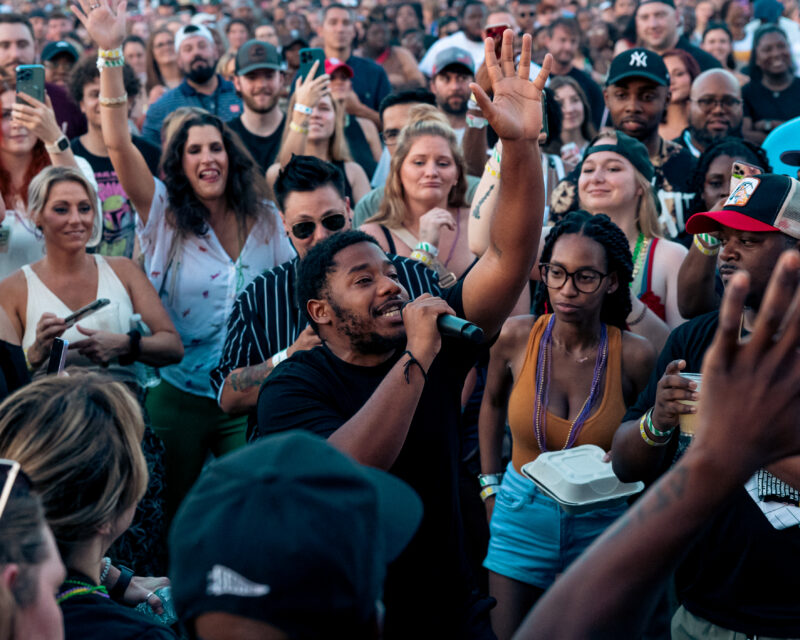
Woodstock. Glastonbury. Rock in Rio. Primavera Sound. Tomorrowland. Coachella. Lollapalooza. The list of the world’s biggest and most popular music festivals goes on and on seemingly forever. From your hometown street festival with a lineup of local talent to the world stage, musical festivals have evolved with each passing year and now find themselves in a momentous place in 2024 — where music, art, commerce and social hierarchy intersect more than ever.
Gatherings to celebrate music date back centuries to the Pythian Games, held in Greece in 6th century B.C., but contemporary music festivals first became popularized with the KFRC Fantasy Fair and Magic Mountain Music Festival in 1967 where The Doors, Jefferson Airplane and Dionne Warwick performed on the side of Mount Tamalpais in Marin County, California. Just a week later, The Monterey International Pop Festival in Monterey, California took place where Jimi Hendrix, Otis Redding and the Who were among the performers and brought approximately 200,000 attendees over three days.
These early rock festivals uncoincidentally happened during the Summer of Love, a phenomenon that took San Francisco by storm and transformed the city into the nucleus of a national hippie movement. A movement celebrating counterculture ideals inspired by the Beatnik generation that prioritized individualistic freedom and emphasized experimentation with drugs and sex. The idyllic aesthetic often associated with the 1960’s owes itself to this concept of “free love,” and emphasis on community popularized by social gatherings in the Bay Area. The birth of what modern music festivals are is intrinsically tied to this idealism of coming together to appreciate each other and enjoy the music that also sometimes reflected this mentality.
Two years after the Summer of Love, Woodstock cemented the modern music festival into popular culture indefinitely. Taking place in Bethel, New York, close to half a million people showed up for three days of “peace and music,” and saw acts such as Jimi Hendrix, The Grateful Dead and Crosby, Stills, Joan Baez, and Nash & Young. Woodstock is immortalized as a blissful communion of togetherness through music, despite the three deaths that occurred and over 5,000 reported medical incidents. In a way, the festival celebrated the end of the 1960’s for all that they were and looked toward the new decade with hope for the new generation. The idealism of the ‘60s would quickly dissolve as the Vietnam war would continue until 1975 and Nixon’s 1972 Watergate scandal altered American politics forever.
In the early days of the modern music festival, these gatherings represented far more than a collection of popular artists playing for audiences — they often represented a concerted interest in changing the way that Americans thought about their politics, lives and the world. Festivals continued to sprout up throughout the following decades, including the start of what would become the U.K.’s Glastonbury Festival in 1970, and reached another pivotal point in the ‘90s as electronic music began to gain prominence.
By the time Woodstock ‘99, an attempt to revive the iconic festival 30 years after its inception, happened, music and the social culture around festivals had drastically changed. Genres such as metal, grunge, hip-hop and punk rock were becoming more popular, and the mindset behind festivals such as Woodstock ‘99 were drastically different compared to the festivals of the ‘60s. The more energetic, and sometimes aggressive, music (such as Korn, Limp Bizkit and the Red Hot Chili Peppers) seemed to redefine festivals such as Woodstock ‘99 as opportunities to focus more on die hard partying and mayhem.Woodstock ‘99 is remembered by its pure chaos, destruction and sheer lack of safety, largely as a result of poor planning.
Though the Woodstock revival failed to recapture the essence of its origin, countless other festivals began sprouting up around the turn of the millennium including Chicago’s Lollapalooza, Barcelona’s Primavera Sound, Belgium’s electronic music festival Tomorrowland, and of course California’s Coachella. As the aughts turned into the 2010’s, technology evolved alongside the impact of music festivals, turning what once were events focused solely on music and community into opportunities for commerce and social status.
Whether it be the prices for VIP packages at Coachella or the phone filled audience during Ice Spice’s performance at Rolling Loud, it’s clear that status and exclusivity have begun to play a bigger role in the music festival scene. Coachella weekend one is notorious for being overly-packed with influencers looking for photo opportunities over fans actually attending for the music. Whether these changes are “good” or “bad” is subjective, but it’s clear that even if there was an effort to regain the kind of uninterrupted and idealist focus on the music and its sociopolitical meanings, that may not be attainable given the now inescapable reality of technology and social media hierarchy.
If you want to read more from our August issue, read the full issue online.
Or you can purchase your physical copy, while supplies last.


